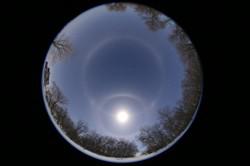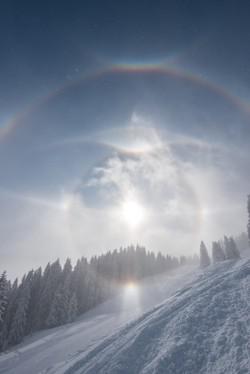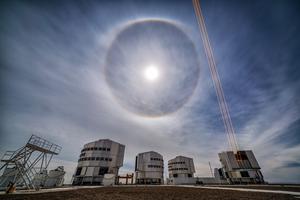Glossary term: Halo
Description: A halo is an optical phenomenon caused by ice crystals in the Earth's atmosphere. Just as refraction and reflection in water droplets causes rainbows, sunlight passing through ice crystals is reflected and refracted within them to form halos. Halos can take many different forms and can be caused by light from the Sun or the Moon. The 22-degree halo is a circular halo that forms as a thin band of light around the Sun or the Moon. The geometry of this halo is the result of the properties of the ice crystals that sunlight or moonlight passes through in the atmosphere.
The word halo is also used in other astronomical contexts, including: galactic halo, dark matter halo, and stellar halo, all of which are some of the major components in the structure of galaxies.
Related Terms:
See this term in other languages
Term and definition status: This term and its definition have been approved by a research astronomer and a teacher
The OAE Multilingual Glossary is a project of the IAU Office of Astronomy for Education (OAE) in collaboration with the IAU Office of Astronomy Outreach (OAO). The terms and definitions were chosen, written and reviewed by a collective effort from the OAE, the OAE Centers and Nodes, the OAE National Astronomy Education Coordinators (NAECs) and other volunteers. You can find a full list of credits here. All glossary terms and their definitions are released under a Creative Commons CC BY-4.0 license and should be credited to "IAU OAE".
If you notice a factual error in this glossary definition then please get in touch.
Related Media
Selene meets the Moon, by Sheila Wiwchar, Canada
Credit: Sheila Wiwchar/IAU OAE
License: CC-BY-4.0 Creative Commons Attribution 4.0 International (CC BY 4.0) icons
Winter Haloes, by Thomas Gigl, Germany
Credit: Thomas Gigl/IAU OAE
License: CC-BY-4.0 Creative Commons Attribution 4.0 International (CC BY 4.0) icons
ESO's Very Large Telescope (VLT) at Paranal Observatory with a lunar halo
Credit: Juan Carlos Muñoz-Mateos/ESO credit link
License: CC-BY-4.0 Creative Commons Attribution 4.0 International (CC BY 4.0) icons
Lunar rainbow and lunar Brocken spectre, by Kouji Ohnishi, Japan
Credit: Kouji Ohnishi/IAU OAE
License: CC-BY-4.0 Creative Commons Attribution 4.0 International (CC BY 4.0) icons












